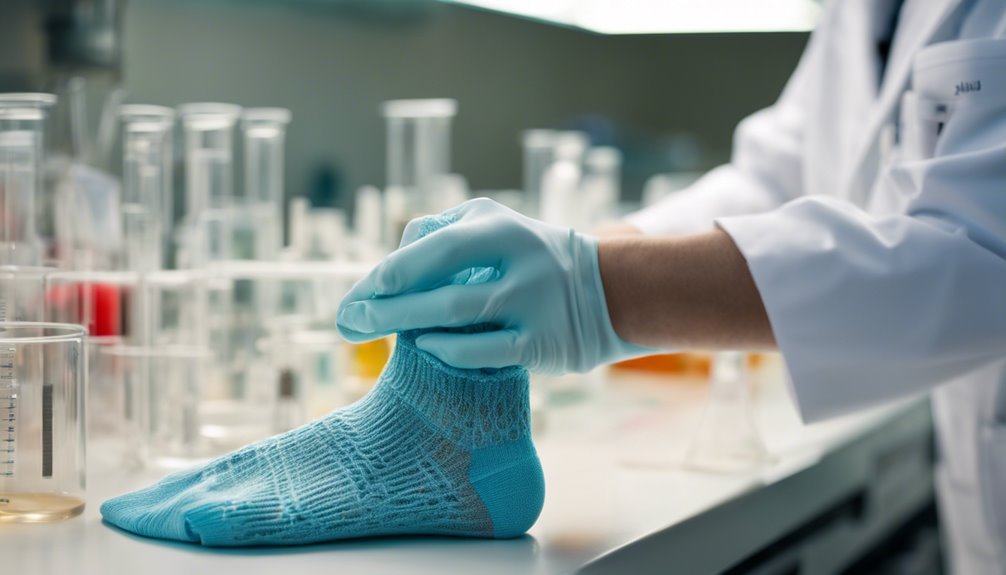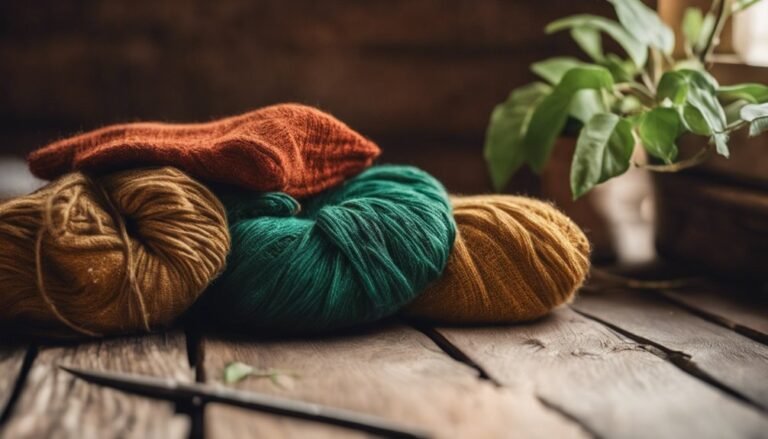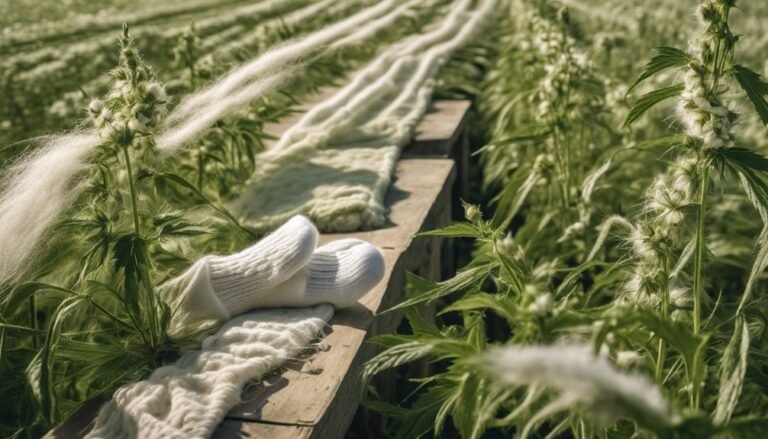Will Socks Made From Lab-Grown Materials Be the Future?
Socks made from lab-grown materials are likely the future of fashion. They cut carbon emissions dramatically and use considerably less water and energy than traditional options. Plus, they offer enhanced performance, durability, and comfort, which is perfect for your active lifestyle. As consumer demand for sustainable fashion grows, these innovative textiles are becoming more appealing. If you're curious about the challenges and advancements in this field, there's more to uncover.
The Science Behind Lab-Grown Materials

While you might think of traditional textiles as being derived solely from natural fibers, the emergence of lab-grown materials is redefining the landscape of fabric production. These innovations are grounded in biotechnology advancements, which allow for unprecedented material synthesis. By harnessing the power of microorganisms and cellular processes, scientists can create fibers that mimic the properties of conventional materials, but with enhanced performance characteristics. Imagine socks that are not only soft and durable but also customizable in texture and resilience. This scientific approach liberates fabric design from nature's limitations, offering you freedom in style and function. As the technology continues to evolve, the potential for lab-grown materials to revolutionize your wardrobe and bolster sustainability becomes increasingly tangible.
Environmental Benefits of Lab-Grown Socks
When you choose lab-grown socks, you're opting for a product that considerably reduces your carbon footprint. These socks are made from sustainable material sources that minimize environmental impact during production. It's a simple yet effective way to make a positive contribution to the planet while enjoying comfort and style.
Reduced Carbon Footprint
As the demand for sustainable fashion grows, lab-grown socks emerge as a compelling solution, considerably reducing the carbon footprint associated with traditional textile production. By utilizing eco-friendly practices, these innovative socks pave the way toward carbon neutrality. Here's a snapshot of their environmental impact compared to conventional socks:
| Aspect | Traditional Socks | Lab-Grown Socks |
|---|---|---|
| Carbon Emissions (kg) | 10 | 2 |
| Water Usage (liters) | 300 | 50 |
| Energy Consumption (kWh) | 5 | 1 |
Choosing lab-grown socks not only means you're stepping into comfort but also actively participating in the movement for a greener planet. Embrace the future of fashion—your feet will thank you!
Sustainable Material Sources
Lab-grown socks are revolutionizing the fashion industry not just through their reduced carbon footprint, but also by utilizing sustainable material sources that greatly benefit the environment. By incorporating biodegradable alternatives, these innovative socks break down naturally, minimizing landfill waste and pollution. You can feel good knowing that every step you take in lab-grown socks contributes to a healthier planet. Additionally, many brands are using recycled fibers, transforming discarded materials into stylish, functional products. This approach not only reduces the need for virgin resources but also reinforces the circular economy. As you embrace these cutting-edge socks, you're supporting a shift towards more sustainable fashion choices, proving that style and environmental responsibility can go hand in hand.
Performance and Comfort: A New Standard
While traditional materials often compromise on either performance or comfort, socks made from lab-grown materials are setting a new standard by seamlessly blending both attributes. You'll find that these innovative socks excel in performance metrics, offering enhanced durability, moisture-wicking capabilities, and temperature regulation. Imagine a sock that not only feels great but also stands up to the demands of your active lifestyle. With advanced comfort technology, these lab-grown fibers adapt to your foot's contours, ensuring a snug yet flexible fit. Whether you're hitting the gym or enjoying a casual day out, you'll appreciate how these socks elevate your experience. As you explore your options, it's clear that the future of sock technology lies in this perfect harmony of performance and comfort.
Consumer Demand for Sustainable Fashion
How important is sustainability to your wardrobe choices? As the demand for sustainable fashion grows, you're likely considering how your purchases align with ethical consumerism. Eco-friendly choices are no longer just a trend; they're becoming essential for conscious consumers like you. Here are three reasons to prioritize sustainability in your fashion decisions:
- Environmental Impact: Sustainable practices reduce waste and conserve resources, helping our planet thrive.
- Ethical Production: Knowing your clothes are made under fair conditions supports workers' rights and communities.
- Quality Over Quantity: Eco-friendly materials often mean longer-lasting products, saving you money in the long run.
Challenges in Production and Adoption

As the appeal of sustainable fashion rises, challenges in production and adoption become more prominent. You might find that production obstacles can hinder the scalability of lab-grown materials. Factors like high costs, limited resources, and technology gaps create roadblocks for manufacturers trying to meet consumer demand. Additionally, market acceptance plays an important role; many consumers remain skeptical about the performance and longevity of socks made from these innovative materials. Educating the public on the benefits of lab-grown textiles is essential, but it takes time to shift mindsets and overcome misconceptions. Without addressing these challenges, the journey toward widespread adoption could be slow, leaving you wondering how soon you can enjoy the comfort of sustainable socks.
The Future of Lab-Grown Textiles in Fashion
As you consider the future of lab-grown textiles in fashion, think about how these innovative materials could considerably reduce environmental impact. Advances in fabric production not only promise sustainability but also open doors to new design possibilities. It's an exciting time where fashion and science intersect, reshaping what we wear and how it's made.
Environmental Impact Considerations
While the fashion industry has long been criticized for its environmental footprint, the emergence of lab-grown textiles presents a promising shift towards sustainability. By opting for lab-grown materials, you're not only reducing waste but also supporting biodegradable options that can redefine how we view fashion. Here are three key environmental benefits to take into account:
- Waste Reduction: Lab-grown textiles minimize the excess material typically generated in traditional manufacturing processes.
- Resource Efficiency: These materials often require less water and energy, leading to a smaller ecological footprint.
- Biodegradable Options: Many lab-grown fabrics can break down naturally, reducing landfill contributions.
Choosing lab-grown socks could be your step towards a more sustainable wardrobe, empowering you to make a positive impact on the planet.
Innovation in Fabric Production
The future of lab-grown textiles is poised to revolutionize the fashion industry, especially as innovative production techniques emerge that enhance both quality and sustainability. With biotechnology advancements, you can expect a new era in textile engineering that allows for the creation of fabrics that are not only durable but also environmentally friendly. Imagine socks made from lab-grown fibers that mimic the softness of cotton while being entirely synthetic and biodegradable. These breakthroughs can lead to reduced waste and a smaller carbon footprint, giving you freedom from the guilt often associated with fast fashion. As these technologies continue to evolve, you'll find yourself wearing garments that reflect a commitment to both style and sustainability, paving the way for a more responsible fashion future.
Frequently Asked Questions
Are Lab-Grown Socks More Expensive Than Traditional Socks?
When you look at price comparison, lab-grown socks often come with a higher price tag. Consumer perception suggests that sustainability and innovation justify this cost, but it ultimately depends on your values and priorities.
Where Can I Buy Lab-Grown Socks?
You're curious about where to find lab-grown socks, right? Check out online sustainable fashion retailers or ethical consumerism platforms. They often feature innovative brands dedicated to eco-friendly materials and practices, ensuring you make a conscious choice.
How Do Lab-Grown Socks Compare to Organic Cotton Socks?
When comparing lab-grown socks to organic cotton ones, you'll find lab-grown materials often offer enhanced sustainability benefits. However, with regard to comfort comparison, organic cotton tends to provide a softer, more breathable experience.
Can Lab-Grown Materials Be Recycled?
Imagine a world where waste vanishes like mist in the morning sun. Lab-grown materials can be recycled, addressing sustainability concerns through innovative recycling processes, transforming discarded items into new resources, offering freedom from environmental guilt.
What Brands Are Leading in Lab-Grown Sock Production?
You'll find brands like Allbirds and Patagonia at the forefront of sustainable fashion, utilizing innovative materials to produce lab-grown socks. Their commitment to eco-friendly practices showcases a promising shift towards more responsible consumer choices.







